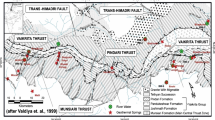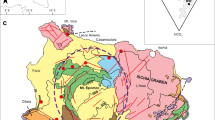Abstract
Anatolia region is one of the most seismically active regions in the world and has a considerably high level of geothermal energy potential. Some of these geothermal resources have been used for power generation and direct heating. Most of the high enthalpy geothermal systems are located in western part of Turkey. Alasehir is the most important geothermal site in western part of Turkey. Many geothermal wells have been drilled in Alasehir Plain to produce the geothermal fluid from the deep reservoir in the last 10 years. A blowout accident happened during a geothermal well drilling operation in Alasehir Plain, and significant amount of geothermal fluid surfaced out along the fault zone in three locations. When drilling string entered the reservoir rock about 1000 m, blowout occurred. As the well head preventer system was closed because of the blowout, high-pressure fluid surfaced out along the fault zone cutting the Neogene formation. In order to understand the geothermal fluid effects on groundwater chemistry, physical and chemical compositions of local cold groundwater were monitored from May 2012 to September 2014 in the study area. The geothermal fluid was found to be of Na–HCO3 water type, and especially, arsenic and boron concentrations reached levels as high as 3 and 127 mg/L, respectively. The concentrations of arsenic and boron in the geothermal fluid and groundwater exceeded the maximum allowable limits given in the national and international standards for drinking water quality. According to temporally monitored results, geothermal fluid has extremely high mineral content which influenced the quality of groundwater resources of the area where water resource is commonly used for agricultural irrigation.





(modified from Toka et al. 2012)






Similar content being viewed by others
References
Aksoy N, Simsek C, Gunduz O (2009) Groundwater contamination mechanism in a geothermal field: a case study of Balcova, Turkey. J Contam Hydrol 103:13–28
ASTM D1067-16 (2016) Standard test methods for acidity or alkalinity of water. American Society of the International Association for Testing and Materials (ASTM) International, West Conshohocken. www.astm.org
ASTM D512-12 (2016)Standard test methods for chloride ion in water. American Society of the International Association for Testing and Materials (ASTM) International, West Conshohocken. www.astm.org
ASTM D516-16 (2016) Standard test method for sulfate ion in water. American Society of the International Association for Testing and Materials (ASTM) International, West Conshohocken. www.astm.org
AWWA (1995) Chemical oxygen demand, argentometric method. In: Standard methods for the examination of water and wastewater, 4th Edition, no. 49. Washington, American Waste Water Association (AWWA), American Public Health Association, pp 5–12
Axtmann CR (1975) Environmental impact of a geothermal power plant. Science 187(4179):795–803
Baba A (2012) Present energy status and geothermal utilization in Turkey IAH 2012 Niagara Falls, Canada, pp 1–3
Baba A, Ármannsson H (2006) Environmental impact of the utilization of a geothermal area in Turkey. Energy Sour 1:267–278
Baba A, Murathan A (2012) The influence of geothermal fluid with high heavy metals concentration on water resources, vol 66. Geological Congress of Turkey. April 2012, Ankara, pp 124–125
Baba A, Sözbilir H (2012) Source of arsenic based on geological and hydrogeochemical properties of geothermal systems in Western Turkey. Chem Geol 334:364–377
Baba A, Gunduz O, Simsek C, Elci A, Murathan A, Sozbilir H (2016) High arsenic levels in groundwater resources of Gediz, Western Turkey. In: Arsenic research and global sustainability, AS2016 Proceedings, 19–23 June 2016, Stockholm, Sweden, pp 35–36
Bozkurt E (2001) Neotectonics of Turkey-a synthesis. Geodin Acta 14:3–30
Bozkurt E (2003) Origin of NE-trending basins in western Turkey. Geodin Acta 16:61–81
Demirel Z, Yildirim N (2002) Boron pollution due to geothermal wastewater discharge into the Buyuk Menderes River, Turkey. Int J Environ Pollut 18:602–608
Dogdu MS, Bayari CS (2005) Environmental impact of geothermal fluids on surface water, groundwater and streambed sediments in the Akarcay Basin, Turkey. Environ Geol 47:325–340
DSI (2014) Hydrogeological report for Gediz Plain. Turkey State Hydraulic Works, Izmir
ITHASY (2005). Regulation on waters for human consumption. Official Gazette dated 17/02/2005 No. 25730 Ankara (in Turkish)
Kocyigit A, Yusufoglu H, Bozkurt E (1999) Evidence from the Gediz graben for episodic two-stage extension in Western Turkey. J Geol Soc London 156:605–616
MTA (1980) Hot and mineral water inventory. MTA Report, Ankara
Ozen T, Bulbul A, Tarcan G (2010) Reservoir and hydrogeochemical characterizations of the salihli geothermal fields in turkey. In: Proceedings world geothermal congress 2010, Bali Indonesia 25–29 April 2010, pp 1–10
Rabet RS (2015). Investigation of geothermal waters effects on groundwater quality in Alasehir plain. MsTesis, Dokuz Eylul University, The Graduate School of Applied Science, Izmir
Seyitoglu G, Cemen İ, Tekeli O (2002) Discussion on the extensional folding in the Alasehir (Gediz) graben, western Turkey (reply). J Geol Soc 159:105–109
Simsek S (1997) Geothermal potential in northwestern Turkey. Active tectonics of Northwestern Anatolia. In: Pfister M, Schindler C (eds) The marmara poly-project. vdfhochschulverlag AG an der ETH, Zurich, pp 111–123
Simsek S (2009) Geothermal energy development Possibilities in Turkey. In: Numow conference on geothermal energy in Turkey, October, 2009 Potsdam-Germany, pp 1–6
Simsek C (2016). Investigation of geothermal waters effects on groundwater quality in Alasehir plain, Dokuz Eylul University Research Project, Project No: 2014.KB.FEN.012
Simsek S, Yildirim N, Simsek ZN, Karakus H (2002) Changes in geothermal resources at earthquake regions and their importance. In: Middle Anatolian geothermal energy and environmental symposium, pp 1–13
Sözbilir H (2002) Geometry and origin of folding in the Neogene sediments of the Gediz Graben, western Anatolia, Turkey. Geodin Acta 15:277–288
Toka B, Tugran M, Yıldız M, Durak S, Karadeniz N (2012) Technical report for geothermal eruption near Alkan Vilage in Alasehir Plain. TMMOB Chamber of Mining Engineering, Izmir
WHO (2004) World health organization. Guidelines for drinking water quality. Office of Water U.S. Environmental Protection Agency Washington DC
Yigitbas E, Elmas A, Sefinc A, Ozer N (2004) Major neotectonic features of eastern Marmara region, Turkey: development of the Adapazari-Karasu corridor and its tectonic significance. Geol J 39:179–198
Acknowledgements
This research was funded by Scientific Research Project Fund of Dokuz Eylul University through Grant No: 2014.KB.FEN.012. The authors would like to thank State Hydraulic Works for the valuable support provided during the course of the study. The authors would like to thank Dr. Orhan Gunduz for reviewing the manuscript.
Author information
Authors and Affiliations
Corresponding author
Rights and permissions
About this article
Cite this article
Rabet, R.S., Simsek, C., Baba, A. et al. Blowout mechanism of Alasehir (Turkey) geothermal field and its effects on groundwater chemistry. Environ Earth Sci 76, 49 (2017). https://doi.org/10.1007/s12665-016-6334-6
Received:
Accepted:
Published:
DOI: https://doi.org/10.1007/s12665-016-6334-6




